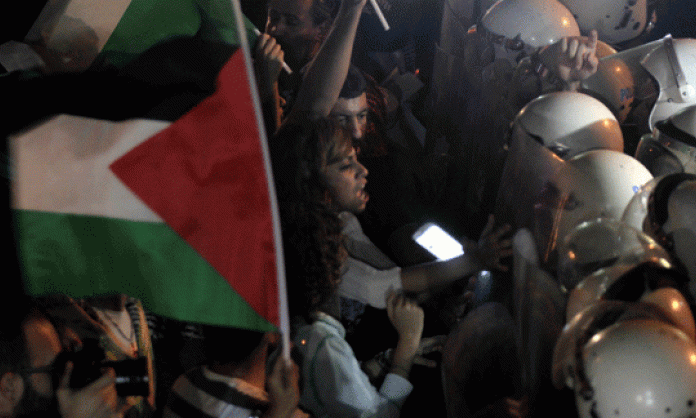For Muslims, Laylat al-Qadr is the holiest night of Ramadan, which is the holiest month in the calendar. This year, the night witnesses more violent Palestinian deaths.
Mohammed al-Araj (19) and Majd Sufyan (27) were killed on 24 July when Israeli forces opened fire on more than 20,000 protesters in the Occupied West Bank. One participant told Red Flag that more than 1,000 Palestinian youth – both men and women – subsequently clashed with Israeli soldiers. More than 280 Palestinians were injured as a result of further Israeli military fire.
The demonstration, the largest in almost a decade, called for Palestinians to “deliver a message to Gaza people that you don’t stand alone against this brutal offensive”. Anger also was fuelled by Israel’s refusal to issue permits enabling West Bank Palestinians to pray at al-Aqsa mosque.
Beginning at al-Amari refugee camp two kilometres south of Ramallah, the protesters had marched towards Qalandia, the main Israeli checkpoint between Ramallah and Occupied East Jerusalem.
Since the kidnapping, torture and murder of Palestinian teenager Mohammed Abu Khdeir on 4 July, there have been daily confrontations and protests in both Occupied East Jerusalem and throughout the Occupied West Bank in cities such as Bethlehem.
Palestinians in the West Bank staged a general strike on 21 July in the wake of the Shejaiya massacre, during which Israel all but levelled the eastern district of Gaza City, killing almost 100 people. Palestinian shops, businesses and institutions closed their doors for the day. According to the Palestine News Network more than 1,500 Palestinians took part in the demonstrations in Bethlehem. Demonstrations also took place in Ramallah, Hebron, Nablus, Tulkarem and Occupied East Jerusalem.
Palestinian citizens of Israel also joined the general strike. In Nazareth, the main commercial street was closed and up to 10,000 protested. Israeli police arrested at least a dozen demonstrators. Since early July, the Israeli state has arrested more than 930 Palestinians in both East Jerusalem and from Palestinian towns and districts inside Israel.
As news spread of the use of live ammunition and the deaths at the Qalandia march, spontaneous protests broke out in Hebron, Bethlehem, Tulkarem and Nablus. Protests also took place in Occupied East Jerusalem, where Palestinians attacked and burned an Israeli military post.
For weeks the Fatah-dominated Palestinian Authority (PA) and its police force have suppressed demonstrations in support of Gaza. Fatah leader Mahmoud Abbas has refused to end “security coordination” with Israel, describing it in May as “sacred”.
In July, an increasing level of violence was used by the PA against Palestinian demonstrators, including the use of weapons of the occupation army – tear gas, sound grenades and live ammunition. Abbas and the PA are viewed by many Palestinians, particularly the youth, as little more than a “subcontractor for Israel”. In fact, amid the anti-Israel demonstrations, there have also been demonstrations against the PA police.
Yet the growing outrage at PA collaboration resulted in a shift at the end of July. Fatah’s Al-Aqsa Martyrs’ Brigade – which has not engaged in armed struggle in the Occupied West Bank for the past seven years – claimed it had engaged in a fire fight with Israeli troops. According to Palestinian media outlet Ma’an News, the gun battle took place concurrently with the Qalandia march.
The PA subsequently called for a “day of rage” on 25 July. Tens of thousands of Palestinians joined demonstrations across the West Bank. The biggest protests taking place in Jenin, Bethlehem and Nablus. Israeli occupation forces killed seven and wounded hundreds more.
In Abu Dis, on the outskirts of East Jerusalem, dozens of protesters attempted to break holes in the apartheid wall. In Tulkarem, thousands marched on Netanyah Checkpoint. In Bethlehem at least 3,000 people took part in a rally that marched from Manger Square to the apartheid wall at Rachel’s Tomb.










